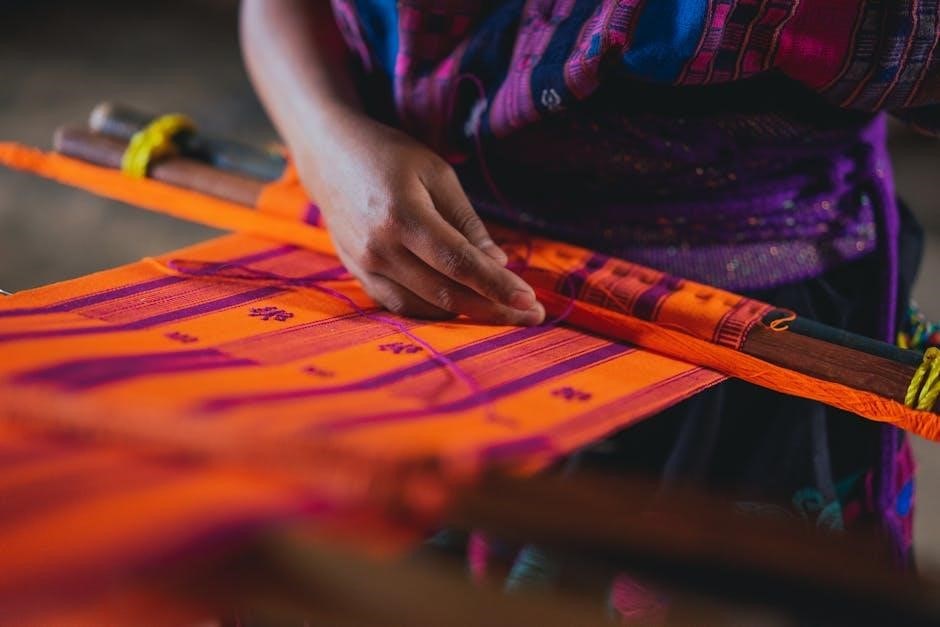Learning to knit socks with a loom is easy and fun‚ using reliable sock knitting looms and free patterns available online always helps beginners.
Overview of Loom Knitting
Loom knitting is a fun and easy way to create socks and other items‚ with many resources available online to help beginners get started.
Using a loom can be a great alternative to traditional knitting needles‚ and many people find it to be a more comfortable and efficient way to knit;
Loom knitting kits are available for purchase‚ which often include everything needed to get started‚ including the loom‚ yarn‚ and instructions.
These kits can be a great way for beginners to learn the basics of loom knitting and start creating their own projects‚ including socks and other accessories‚ with ease and confidence always.

Choosing the Right Loom
Selecting a suitable loom is essential for successful sock knitting projects always requires careful consideration of options available online today.
Types of Looms
There are several types of looms available for sock knitting‚ including round‚ oval‚ and square looms‚ each with its own unique characteristics and benefits. The choice of loom depends on the type of sock being made and the level of complexity desired. Some looms are designed for beginners‚ while others are more suited for experienced knitters. Additionally‚ some looms come with interchangeable parts‚ allowing for greater versatility and creativity in sock design. Overall‚ understanding the different types of looms is essential for selecting the right one for a particular project and achieving the desired results with ease and efficiency always matters.
Understanding Sock Loom Instructions
Reading and following instructions carefully is essential for successful sock loom knitting projects always requires patience and practice every time.
Reading Patterns
To successfully complete a sock loom project‚ it is crucial to understand how to read patterns‚ which involves interpreting written instructions and diagrams.
The ability to read patterns is a fundamental skill that every crafter should possess‚ as it enables them to bring their creative ideas to life.
By learning how to read patterns‚ crafters can create a wide range of items‚ from simple accessories to complex garments‚ using their sock loom.
This skill also allows them to modify existing patterns and create their own unique designs‚ which can be a fun and rewarding experience.
Overall‚ reading patterns is an essential part of the sock loom crafting process.
Casting On
Mastering the e-wrap cast on technique is essential for sock loom knitting projects always.
E-Wrap Cast On
The e-wrap cast on is a popular method for sock loom knitting‚ creating a stretchy edge perfect for comfortable socks. This technique is easy to learn and master‚ with many online resources available to guide beginners. The e-wrap cast on is suitable for various types of socks‚ including ankle‚ crew‚ and boot socks. To achieve a professional finish‚ it is essential to maintain even tension while casting on. With practice‚ the e-wrap cast on becomes a straightforward process‚ allowing knitters to focus on the rest of their project. Many tutorials and videos demonstrate this technique in detail‚ making it accessible to all skill levels‚ and providing a great starting point for sock loom knitting projects‚ and helping to ensure a successful outcome.
Knitting the Sock
Knitting a sock involves creating a tube using a loom and yarn‚ following a pattern or instructions carefully always.
Calculating Stitches
To calculate stitches‚ you need to consider the type of yarn and loom being used‚ as well as the desired fit of the sock.
Using a calculator or interactive tool can help simplify the process and ensure accurate results‚ which is crucial for a comfortable fit.
The number of stitches will determine the width of the sock‚ and getting this right is essential for a well-fitting sock.
By following a few simple steps and using the right tools‚ you can easily calculate the stitches needed for your sock‚ and start knitting with confidence‚ every time‚ with great results always.

Working the Heel
Heel construction requires careful attention to stitch count and tension always matters greatly in sock loom knitting projects every time.
Heel Stitch
The heel stitch is a critical component of sock loom knitting‚ requiring a specific sequence of stitches to shape the heel of the sock properly.
Using a loom to knit the heel stitch can be challenging‚ but with practice and patience‚ it can be mastered‚ and the result is a comfortable and well-fitting sock.
The heel stitch is typically worked in a specific pattern‚ and the number of stitches and rows can vary depending on the size and type of sock being knit‚ and the desired fit and style of the sock.
Loom knitting tutorials and patterns often provide detailed instructions and guidance on working the heel stitch‚ and other techniques for knitting socks with a loom.
Shaping the Toe
Shaping the toe requires decreasing stitches to form a pointed shape using a loom knitting technique always.
Kitchener Stitch
The Kitchener stitch is a technique used to join two sets of stitches together seamlessly‚ it is commonly used to close the toe of a sock.
This stitch is important in loom knitting as it allows for a professional finish to the sock‚ without any visible seams or joins.
The Kitchener stitch can be a bit tricky to learn at first‚ but with practice it becomes easier and is a valuable skill to have in loom knitting.
It is often used in conjunction with other stitches and techniques to create a wide range of sock styles and designs‚ making it a versatile stitch.

Finishing the Sock
Finishing a sock involves seaming and weaving in ends to create a professional finish always using a yarn needle carefully.
Seaming the Sock
To seam a sock‚ use a yarn needle and yarn to sew the toe seam‚ making sure to match the stitches carefully and weave in ends; This step is crucial in completing the sock and giving it a professional finish. The seam should be secure and comfortable to wear. Using a tapestry needle can also help to weave in ends and sew the seam. It is essential to follow the pattern instructions for seaming the sock to ensure a proper fit and finish. Seaming the sock requires patience and attention to detail to achieve a comfortable and durable sock.

Tips and Tricks
Using loom knitting kits and online tutorials helps beginners learn new skills quickly and easily every time they try something new online.
Customizing the Sock
Customizing socks with a loom is easy‚ allowing users to create unique designs and patterns using different yarns and colors‚ making each sock special and personalized.
With a loom‚ users can experiment with various stitch patterns and yarn weights to create socks that fit their individual style and preferences‚ from casual to dressy.
Loom knitting also enables users to make socks in various sizes‚ from small to large‚ making it a great way to create gifts for friends and family members with different foot sizes.
Overall‚ customizing socks with a loom is a fun and creative way to express oneself through knitting.
Loom knitting socks is a fun and rewarding experience with many resources available online always helping beginners succeed quickly and easily now.
Final Thoughts
Learning to knit socks with a loom requires patience and practice‚ but with reliable resources and free patterns‚ beginners can succeed quickly and easily now. Many online tutorials and videos provide step-by-step instructions and tips for getting started with loom knitting socks. Additionally‚ joining online communities and forums can connect beginners with experienced knitters who can offer advice and support. With the right tools and resources‚ anyone can learn to knit socks with a loom and create comfortable and stylish footwear for themselves and others‚ making it a fun and rewarding hobby. Loom knitting socks is a skill that can be learned.
